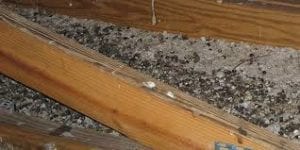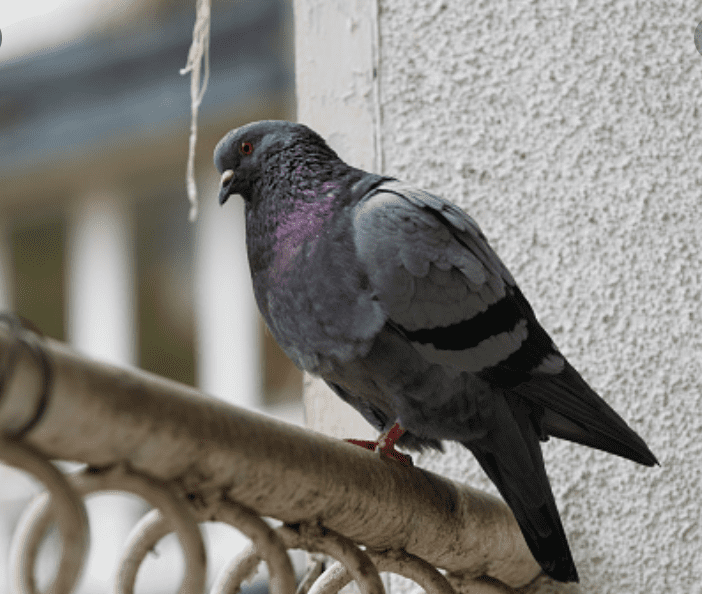
by Pigeon Patrol | May 30, 2023 | Bird Spike, Pigeon Droppings, Pigeon Patrol's Services, Pigeon Predators, Pigeon Spikes, Pigeons, Pigeons in the News
Some people enjoy spending time around pigeons in parks or sidewalks and feeding them seeds or bread crumbs, while others see pigeons as pests that harbor dangerous diseases. No matter whether you love pigeons or hate them, they do spread diseases that can infect humans. Psittacosis is one of these diseases. Occasionally being around pigeons is unlikely to lead to infection. But certain circumstances surrounding homes and businesses can put people at risk of becoming infected. So it’s important to learn about the symptoms and how pigeons spread psittacosis.
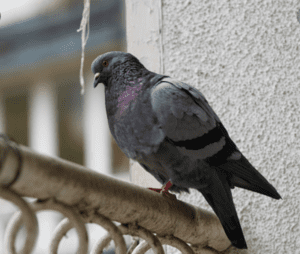
What Is Psittacosis?
Psittacosis is a respiratory illness that humans obtain from a type of bacteria (Chlamydia psittaci ) shed by birds. Sometimes called parrot fever or ornithosis, the disease can affect many different species of birds. Infected birds can become very sick or show no symptoms at all, making it difficult to know if surrounding people are at risk. Whether birds have symptoms or not, they can still pass the disease to people and other mammals.
Infected birds with and without symptoms shed the bacteria in respiratory secretions and droppings. When these secretions and droppings dry, they form dust that spreads through the air and can be inhaled into human respiratory systems. People get the disease by breathing in dried dust particles — that’s how pigeons spread psittacosis. However, it can be spread through bites or beak-to-mouth contact.
People of any age can contract psittacosis, but it’s most common among bird owners or people who work in bird-related occupations. However, psittacosis in pigeons can present additional points of infection. The illness has a rapid transmission rate among birds and thrives in overcrowded areas, like roosting spaces and nests. So it’s likely that massive flock outbreaks occur among pigeons.
Psittacosis Symptoms
Most often, psittacosis symptoms are similar to flu symptoms. However, symptoms can become severe and include pneumonia. If you suspect you’ve been infected with psittacosis, it’s necessary to seek medical attention since antibiotic treatment is required. Symptoms may include:
- • Dry cough
- • Fever
- • Chills
- • Headache
- • Muscle aches
- • Nausea/vomiting
- • Sore throat
- • Difficulty breathing in severe cases
- • Chest pain in severe cases
- • Pneumonia in severe cases
- • Nosebleeds in severe cases
- • Swelling of organs in severe cases
Treatment
Psittacosis is considered rare in humans since only 50 to 200 cases each year are reported. However, many researchers think the illness is under-reported; the symptoms mimic common illnesses like the flu, and the point of infection often goes unnoticed. Severe cases of psittacosis require medical treatment for recovery. Antibiotic therapy is the primary treatment for individuals with psittacosis (typically tetracycline or doxycycline).
How Pigeons Spread Psittacosis
While people also call psittacosis ‘parrot disease,’ any bird susceptible to the bacteria can spread infection. Since pigeons travel and roost in large flocks, it’s likely that the disease spreads readily among pigeons in crowded areas. Sick birds can exhibit symptoms like red, watery eyes, nasal discharge, lethargy, ruffled feathers, diarrhea, and a poor appetite. Alternatively, they can exhibit no symptoms at all. It’s suspected that pigeons have genetic resistance that makes them more likely to show no symptoms and, consequently, become carriers.
In many cities, workspaces, and areas around homes, pigeons roost in large groups and leave piles of feces that must be cleaned away regularly. These areas create potential infection points for people. Once you know how pigeons spread psittacosis, you can focus on maintenance tasks that minimize the risks.
Psittacosis Dangers for Homeowners
Pigeons are common in both urban and rural areas. Unfortunately, when they decide to infest the space around your home, you might find them roosting over your patio, on your children’s play equipment, or even in your attic. If you have pigeons roosting around your home, they leave piles of droppings anywhere they flock. After what you’ve learned about how pigeons spread psittacosis, imagine sweeping piles of dried droppings from your patio — or worse, your attic. When pigeons spend their nights or evenings on playhouses or swing sets, they put your children at risk of getting psittacosis when they go outside to play.
Short of avoiding the spaces you enjoy outdoors, it’s nearly impossible to completely eliminate the risk of psittacoses exposure when you have a pigeon infestation. The solution is deterrence. Visual bird deterrents include lights, holographic devices, and decoy owls or other decoy predators that can be used to frighten pigeons away from your home and yard. Audio bird deterrents work best for residences without pets. They use distress calls and frightening noise to scare birds away.
Psittacosis in Commercial Settings
Commercial properties are even more likely than homes to attract flocking pigeons. If you’ve dealt with pigeons at your business property, you know all the spaces where they leave piles of droppings (and the damage they can cause). As a business owner, you know bird droppings and the health risks of psittacosis present a variety of worries. Droppings on storefronts, trash cans, streetlights, sidewalks, parking lots, railings, and any of the other places pigeons roost have the potential to endanger your customers and employees, as well as your own health. Even worse, when pigeons get inside your commercial building, they can pose additional threats by accessing your storage.
As a business owner, you have a responsibility to keep your landscape and business clean. But cleaning away bird droppings can present risks. OSHA recommends precautions to protect workers from contracting the disease through inhalation. However, deterrence can help you avoid all the problems associated with pigeons and their effect on commercial spaces. While visual and audio deterrents are useful in commercial settings, other measures might also be required. Bird spikes and optical gel are both popular solutions for deterring pigeons in commercial spaces.
Learning about how pigeons spread psittacosis and the dangers caused by pigeon droppings can help you understand the disease’s symptoms and ways you can avoid infection. Safely and humanely deterring pigeon flocks is the best way to avoid dangers from their droppings and the damage they cause around your home or business. To learn more about psittacosis and other diseases that can be spread in pigeon droppings, get in touch with our bird control experts.
Source
Pigeon Patrol Products & Services is the leading manufacturer and distributor or bird deterrent (control) products in Canada. Pigeon Patrol products have solved pest bird problems in industrial, commercial, and residential settings since 2000, by using safe and humane bird
deterrents with only bird and animal friendly solutions. At Pigeon Patrol, we manufacture and offer a variety of bird deterrents, ranging from Ultra-flex Bird Spikes with UV protection, Bird Netting, 4-S Bird Gel and the best Ultrasonic and audible sound devices on the market today.
Voted Best Canadian wholesaler for Bird Deterrent products ten years in a row.
Contact us at 1 877-4-NO-BIRD,(604) 585-9279 or visit our website at www.pigeonpatrol.ca
Pigeon/Pigeon Patrol / Pigeons Roosing / Vancouver Pigeon Control / Bird Spikes / Bird Control / Bird Deterrent / PIgeon Deterrent / Surrey Pigeon Control / Pest / Seagull deterrent / Vancouver Pigeon Blog / Birds Inside Home / Pigeons in the cities / Ice Pigeons / What to do about pigeons / sparrows, Damage by Sparrows, How to Keep Raccoons Away, Why Are Raccoons Considered Pests / De-fence / Pigeon Nesting / Bird Droppings / Pigeon Dropping / woodpecker control / Professional Bird Control Company / Keep The Birds Away / Birds/rats/seagull/pigeon/woodpecker/dove/sparrow/pidgeon control/pidgeon problem/pidgeon control/flying rats/pigeon problems/ bird netting/bird gel/bird spray/bird nails/bird guard
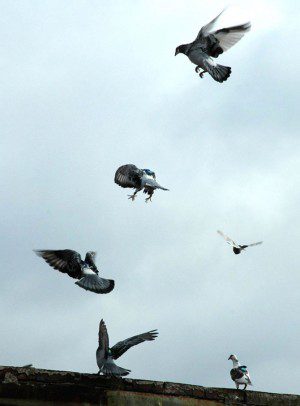
by Pigeon Patrol | May 23, 2023 | Bird Spike, Pigeon Droppings, Pigeon Patrol's Services, Pigeon Predators, Pigeon Spikes, Pigeons, Pigeons in the News
Pigeons are always on the lookout for a source of food and buildings with plenty of high nooks and crannies to roost and nest in, and your factory might just fit the bill.
But if pigeons get into your factory, it’s a serious problem. These pest birds and their guano (poo) carry and spread some nasty diseases, and they can also damage property. This is bad news for any business, but if food is manufactured, packaged, and stored in your factory, it can be disastrous.
Before your reputation and your profits take a serious hit, read our advice on how you can keep pigeons out of your factory.
How to prevent pigeons from getting into your factory
First, eliminate any sources of food
Any sources of food will be very attractive to pigeons, and eliminating them will make your factory less desirable to roost or nest in. Keep your factory scrupulously clean and don’t leave food ingredients or waste lying around, inside or outside of the premises.
It’s also a good idea to talk to nearby businesses if their poor waste management or housekeeping practices are attracting pest birds to the vicinity.
Second, use deterrents
When you are trying to prevent pigeons from nesting or roosting in or on your property, deterrents like bird spikes, bird wire, and netting can be effective at keeping them at bay.
Third, fix up your factory
If there are holes in your factory roof or walls that you haven’t got around to fixing, you could inadvertently be providing pigeons with the perfect nesting place. Make sure you fix them up-deterring pigeons is all about making your factory much less attractive to them.
Finally, deal with the guano
As we mentioned earlier, pigeon droppings can contain some harmful bacteria, so we would recommend that you don’t try to clean it up yourself.
If pest pigeons have made a mess of your factory, call in the professionals. We will blast away guano with the right equipment and products so your premises is clean, safe, and hygienic again.
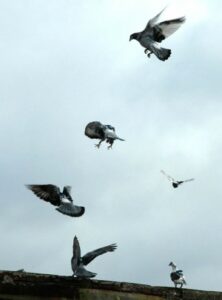
Do I need professional pigeon control for my factory?
As birds are protected by the Wildlife and Countryside Act 1981, it’s illegal to poison or shoot them if you don’t have a license. If you put poison down, you could harm other birds and end up in legal trouble. And not only that, if you’re a food business, you won’t be able to use toxic bird control methods anyway as you could contaminate your product.
If you hire professional pest control, you can get your pest problem dealt with fast. We can deal with any existing infestation, install effective bird-proofing and deterrents, and give you expert advice on preventing any problems in the future.
Source
Pigeon Patrol Products & Services is the leading manufacturer and distributor or bird deterrent (control) products in Canada. Pigeon Patrol products have solved pest bird problems in industrial, commercial, and residential settings since 2000, by using safe and humane bird
deterrents with only bird and animal friendly solutions. At Pigeon Patrol, we manufacture and offer a variety of bird deterrents, ranging from Ultra-flex Bird Spikes with UV protection, Bird Netting, 4-S Bird Gel and the best Ultrasonic and audible sound devices on the market today.
Voted Best Canadian wholesaler for Bird Deterrent products ten years in a row.
Contact us at 1 877-4-NO-BIRD,(604) 585-9279 or visit our website at www.pigeonpatrol.ca
Pigeon/Pigeon Patrol / Pigeons Roosing / Vancouver Pigeon Control / Bird Spikes / Bird Control / Bird Deterrent / PIgeon Deterrent / Surrey Pigeon Control / Pest / Seagull deterrent / Vancouver Pigeon Blog / Birds Inside Home / Pigeons in the cities / Ice Pigeons / What to do about pigeons / sparrows, Damage by Sparrows, How to Keep Raccoons Away, Why Are Raccoons Considered Pests / De-fence / Pigeon Nesting / Bird Droppings / Pigeon Dropping / woodpecker control / Professional Bird Control Company / Keep The Birds Away / Birds/rats/seagull/pigeon/woodpecker/dove/sparrow/pidgeon control/pidgeon problem/pidgeon control/flying rats/pigeon problems/ bird netting/bird gel/bird spray/bird nails/bird guard

by Pigeon Patrol | May 18, 2023 | Bird Spike, Pigeon Droppings, Pigeon Patrol's Services, Pigeon Predators, Pigeon Spikes, Pigeons
Pigeons are among the most common birds we encounter in our daily lives, yet their biology is surprisingly complex. Their adaptability and digestive capabilities allow them to thrive in a wide range of habitats, making them resilient. Biological facts include:
- Pigeons remain with their flocks and mostly eat in groups.
- They wag their heads back and forth as they strut about.
- They are strong, quick fliers, thanks to their long wings and powerful flight muscles.
And here’s one to stump your technicians and customers: Did you know they are one of the only bird species capable of sipping water, rather than having to bend their head back to enable it to flow down their throat?
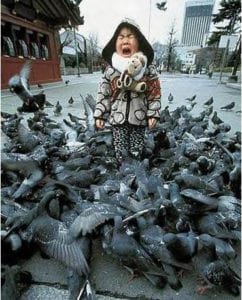
Pigeons terrifying child
FAMILY BEHAVIORS
Pigeons have been observed to be monogamous and exhibit a high degree of parental care:
- They usually lay only one or two eggs at a time, and they hatch after only 17 to 20 days.
- Young pigeons are fed “crop milk” from both male and female parents. This is a white substance secreted on a mature pigeon’s crop, which is basically an enlarged part of the esophagus.
Once these fledglings reach four to six weeks of age, they leave their parents’ nests for good. But before these youngsters have left the nest, more eggs are laid. This occurs during all four seasons, meaning that pigeon numbers increase drastically the longer they are left to their own devices.
Still, these young pigeons remain with the flock and continue to utilize lofts, attics and other concealed locations in and around structures as their roosting spots after they have fled the nest.
A PUBLIC HEALTH PEST
Because of their rapidly increasing numbers, pigeons rely heavily on humans for their food sources, as well as roosting and nesting sites. These birds only require 1 ounce of water per day, meaning just a small amount of stagnant water or snow is all they need. Pigeons in rural regions feed on seed and grain frequently, posing a major problem for farmers. In urban settings, they scavenge for whatever they can find — from littered food in streets and sidewalks to open dumpsters. The more improperly stored and disposed of food supply you provide, the more pigeons you will have.
While pigeons usually live up to 15 years in captivity, feral pigeons often only have a lifespan of 3 to 4 years. They often die of one of the various diseases they are known to carry, or else because of a predator.
Their nesting material, made up of twigs, leaves, and straw, is often reused for the whole year. It hardens after a few uses from their droppings, and is a serious health risk: Not only is the nest where their diseases can spread, it is also a perfect environment for bird mites. Left there long enough, the bird mites spread to whatever other suitable habitat they can find — and often, entire buildings.
Why do pigeons rely so much on humans to survive? There are two main reasons:
- The majority of the North American pigeon population originated from domesticated birds that had escaped. They became accustomed to relying on people for their food and water sources over time, and they stayed near us as a result.
- The various pigeon species have a common ancestor, whose original habitat was cliff sides and steep rock faces, resulting in the common name of “rock dove.” Cities with skyscrapers and tall buildings that provide ledges and overhangs for them to roost on are the closest thing they have to their native homes in many regions,. Thus, they stay there out of instinct.
Source
Pigeon Patrol Products & Services is the leading manufacturer and distributor or bird deterrent (control) products in Canada. Pigeon Patrol products have solved pest bird problems in industrial, commercial, and residential settings since 2000, by using safe and humane bird
deterrents with only bird and animal friendly solutions. At Pigeon Patrol, we manufacture and offer a variety of bird deterrents, ranging from Ultra-flex Bird Spikes with UV protection, Bird Netting, 4-S Bird Gel and the best Ultrasonic and audible sound devices on the market today.
Voted Best Canadian wholesaler for Bird Deterrent products ten years in a row.
Contact us at 1 877-4-NO-BIRD,(604) 585-9279 or visit our website at www.pigeonpatrol.ca
Pigeon/Pigeon Patrol / Pigeons Roosing / Vancouver Pigeon Control / Bird Spikes / Bird Control / Bird Deterrent / PIgeon Deterrent / Surrey Pigeon Control / Pest / Seagull deterrent / Vancouver Pigeon Blog / Birds Inside Home / Pigeons in the cities / Ice Pigeons / What to do about pigeons / sparrows, Damage by Sparrows, How to Keep Raccoons Away, Why Are Raccoons Considered Pests / De-fence / Pigeon Nesting / Bird Droppings / Pigeon Dropping / woodpecker control / Professional Bird Control Company / Keep The Birds Away / Birds/rats/seagull/pigeon/woodpecker/dove/sparrow/pidgeon control/pidgeon problem/pidgeon control/flying rats/pigeon problems/ bird netting/bird gel/bird spray/bird nails/bird guard

by Pigeon Patrol | May 18, 2023 | Bird Spike, Pigeon Droppings, Pigeon Patrol's Services, Pigeon Predators, Pigeon Spikes, Pigeons, Pigeons in the News
In Pittsburgh, Memphis and Los Angeles, massive billboards recently popped up declaring, “Birds Aren’t Real.”
On Instagram and TikTok, Birds Aren’t Real accounts have racked up hundreds of thousands of followers, and YouTube videos about it have gone viral.
Last month, Birds Aren’t Real adherents even protested outside Twitter’s headquarters in San Francisco to demand that the company change its bird logo.
The events were all connected by a Gen Z-fueled conspiracy theory, which posits that birds don’t exist and are really drone replicas installed by the U.S. government to spy on Americans. Hundreds of thousands of young people have joined the movement, wearing Birds Aren’t Real T-shirts, swarming rallies and spreading the slogan.
It might smack of QAnon, the conspiracy theory that the world is controlled by an elite cabal of child-trafficking Democrats. Except that the creator of Birds Aren’t Real and the movement’s followers are in on a joke: They know that birds are, in fact, real and that their theory is made up.
What Birds Aren’t Real truly is, they say, is a parody social movement with a purpose. In a post-truth world dominated by online conspiracy theories, young people have coalesced around the effort to thumb their nose at, fight and poke fun at misinformation. It’s Gen Z’s attempt to upend the rabbit hole with absurdism.
“It’s a way to combat troubles in the world that you don’t really have other ways of combating,” said Claire Chronis, 22, a Birds Aren’t Real organizer in Pittsburgh. “My favorite way to describe the organization is fighting lunacy with lunacy.”
At the center of the movement is Peter McIndoe, 23, a floppy-haired college dropout in Memphis who created Birds Aren’t Real on a whim in 2017. For years, he stayed in character as the conspiracy theory’s chief believer, commanding acolytes to rage against those who challenged his dogma. But now, Mr. McIndoe said in an interview, he is ready to reveal the parody lest people think birds really are drones.
“Dealing in the world of misinformation for the past few years, we’ve been really conscious of the line we walk,” he said. “The idea is meant to be so preposterous, but we make sure nothing we’re saying is too realistic. That’s a consideration with coming out of character.”
Most Birds Aren’t Real members, many of whom are part of an on-the-ground activism network called the Bird Brigade, grew up in a world overrun with misinformation. Some have relatives who have fallen victim to conspiracy theories. So for members of Gen Z, the movement has become a way to collectively grapple with those experiences. By cosplaying conspiracy theorists, they have found community and kinship, Mr. McIndoe said.
“Birds Aren’t Real is not a shallow satire of conspiracies from the outside. It is from the deep inside,” he said. “A lot of people in our generation feel the lunacy in all this, and Birds Aren’t Real has been a way for people to process that.”
Cameron Kasky, 21, an activist from Parkland, Fla., who helped organize the March for Our Lives student protest against gun violence in 2018 and is involved in Birds Aren’t Real, said the parody “makes you stop for a second and laugh. In a uniquely bleak time to come of age, it doesn’t hurt to have something to laugh about together.”
Mr. McIndoe, too, marinated in conspiracies. For his first 18 years, he grew up in a deeply conservative and religious community with seven siblings outside Cincinnati, then in rural Arkansas. He was home-schooled, taught that “evolution was a massive brainwashing plan by the Democrats and Obama was the Antichrist,” he said.
He read books like “Remote Control,” about what it said were hidden anti-Christianity messages from Hollywood. In high school, social media offered a gateway to mainstream culture. Mr. McIndoe began watching Philip DeFranco and other popular YouTubers who talked about current events and pop culture, and went on Reddit to find new viewpoints.
“I was raised by the internet, because that’s where I ended up finding a lot of my actual real-world education, through documentaries and YouTube,” Mr. McIndoe said. “My whole understanding of the world was formed by the internet.”
By the time Mr. McIndoe left home for the University of Arkansas in 2016, he said, he realized he wasn’t the only young person forced to straddle multiple realities.
Then in January 2017, Mr. McIndoe traveled to Memphis to visit friends. Donald J. Trump had just been sworn in as president, and there was a women’s march downtown. Pro-Trump counterprotesters were also there. When Mr. McIndoe saw them, he said, he ripped a poster off a wall, flipped it over and wrote three random words: “Birds Aren’t Real.”
“It was a spontaneous joke, but it was a reflection of the absurdity everyone was feeling,” he said.
Mr. McIndoe then walked around and improvised the Birds Aren’t Real conspiracy lore. He said he was part of a greater movement that believed that birds had been replaced with surveillance drones and that the cover up began in the 1970s. Unbeknown to him, he was filmed and the video posted on Facebook. It went viral, especially among teenagers in the South.
In Memphis, “Birds Aren’t Real” graffiti soon showed up. Photos of the phrase’s being scrawled on chalkboards and the walls of local high schools surfaced. People made “Birds Aren’t Real” stickers.
Mr. McIndoe decided to lean into Birds Aren’t Real. “I started embodying the character and building out the world this character belonged to,” he said. He and Connor Gaydos, a friend, wrote a false history of the movement, concocted elaborate theories and produced fake documents and evidence to support his wild claims.
“It basically became an experiment in misinformation,” Mr. McIndoe said. “We were able to construct an entirely fictional world that was reported on as fact by local media and questioned by members of the public.”
Mr. Gaydos added, “If anyone believes birds aren’t real, we’re the last of their concerns, because then there’s probably no conspiracy they don’t believe.”
In 2018, Mr. McIndoe dropped out of college and moved to Memphis. To build Birds Aren’t Real further, he created a flyer that shot to the top of Reddit. He hired an actor to portray a former C.I.A. agent who confessed to working on bird drone surveillance; the video has more than 20 million views on TikTok. He also hired actors to represent adult bird truthers in videos that spread all over Instagram.
That same year, Mr. McIndoe began selling Birds Aren’t Real merchandise. The money, totaling several thousand dollars a month, helps Mr. McIndoe and Mr. Gaydos cover their living expenses.
“All the money from our merch lineup goes into making sure me and Connor can do this full time,” Mr. McIndoe said. “We also put the money into the billboards, flying out members of the Bird Brigade to rallies. None of the proceeds go to anything harmful.”
To adults with concerns about Mr. McIndoe’s tactics, researchers said any harms were most likely minimal.
“You have to weigh the potential negative effects with any of this stuff, but in this case it is so extremely small,” said Joshua Citarella, an independent researcher who studies internet culture and online radicalization in youth. “Allowing people to engage in collaborative world building is therapeutic because it lets them disarm conspiracism and engage in a safe way.”
Mr. McIndoe said he kept the concerns top of mind. “Everything we’ve done with Birds Aren’t Real is made to make sure it doesn’t tip into where it could have a negative end result on the world,” he said. “It’s a safe space for people to come together and process the conspiracy takeover of America. It’s a way to laugh at the madness rather than be overcome by it.”
The effort has been cathartic for young people including Heitho Shipp, 22, a Pittsburgh resident.
“Most conspiracy theories are fueled by hate or distrust or one powerful leader, but this is about finding an outlet for our pain,” she said. She added that the movement was “more about media literacy.”
Birds Aren’t Real members have also become a political force. Many often join up with counterprotesters and actual conspiracy theorists to de-escalate tensions and delegitimize the people they are marching alongside with irreverent chants.
In September, shortly after a restrictive new abortion law went into effect in Texas, Birds Aren’t Real members showed up at a protest held by anti-abortion activists at the University of Cincinnati. Supporters of the new law “had signs with very graphic imagery and were very aggressive in condemning people,” Mr. McIndoe said. “It led to arguments.”
But the Bird Brigade began chanting, “Birds aren’t real.” Their shouts soon overpowered the anti-abortion activists, who left.
Mr. McIndoe now has big plans for 2022. Breaking character is necessary to help Birds Aren’t Real leap to the next level and forswear actual conspiracy theorists, he said. He added that he hoped to collaborate with major content creators and independent media like Channel 5 News, which is aimed at helping people make sense of America’s current state and the internet.
“I have a lot of excitement for what the future of this could be as an actual force for good,” he said. “Yes, we have been intentionally spreading misinformation for the past four years, but it’s with a purpose. It’s about holding up a mirror to America in the internet age.”
Source
Pigeon Patrol Products & Services is the leading manufacturer and distributor or bird deterrent (control) products in Canada. Pigeon Patrol products have solved pest bird problems in industrial, commercial, and residential settings since 2000, by using safe and humane bird
deterrents with only bird and animal friendly solutions. At Pigeon Patrol, we manufacture and offer a variety of bird deterrents, ranging from Ultra-flex Bird Spikes with UV protection, Bird Netting, 4-S Bird Gel and the best Ultrasonic and audible sound devices on the market today.
Voted Best Canadian wholesaler for Bird Deterrent products ten years in a row.
Contact us at 1 877-4-NO-BIRD,(604) 585-9279 or visit our website at www.pigeonpatrol.ca
Pigeon/Pigeon Patrol / Pigeons Roosing / Vancouver Pigeon Control / Bird Spikes / Bird Control / Bird Deterrent / PIgeon Deterrent / Surrey Pigeon Control / Pest / Seagull deterrent / Vancouver Pigeon Blog / Birds Inside Home / Pigeons in the cities / Ice Pigeons / What to do about pigeons / sparrows, Damage by Sparrows, How to Keep Raccoons Away, Why Are Raccoons Considered Pests / De-fence / Pigeon Nesting / Bird Droppings / Pigeon Dropping / woodpecker control / Professional Bird Control Company / Keep The Birds Away / Birds/rats/seagull/pigeon/woodpecker/dove/sparrow/pidgeon control/pidgeon problem/pidgeon control/flying rats/pigeon problems/ bird netting/bird gel/bird spray/bird nails/bird guard
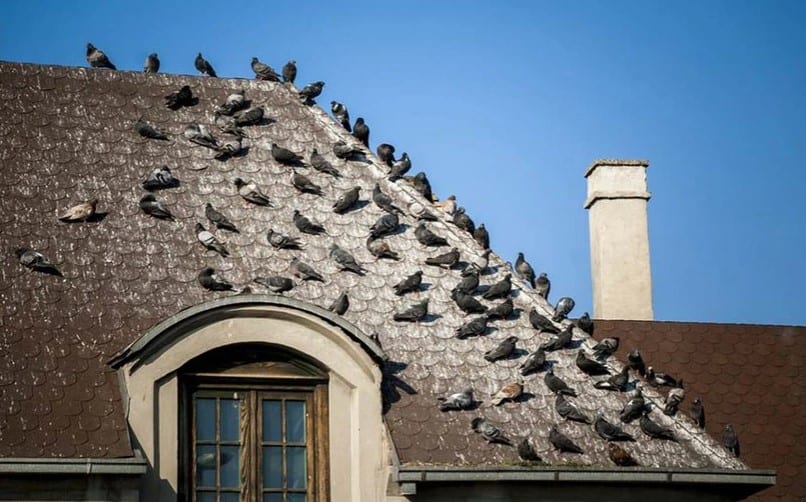
by Pigeon Patrol | May 9, 2023 | history of pigeons, MBCA, pet bird, Pigeon Control, Pigeon Droppings, Pigeon Patrol's Services
“Everybody has a hobby, right? Some have cats, some have dogs. I have pigeons.”
Kulwant Dulay says he’s lived in the District of North Vancouver for 25 years and, for most of them, he’s kept homing pigeons on his property in a coop in the backyard, without ruffling any feathers.
But that changed three years ago when he bought a new house in Lynn Valley. Within a few weeks, his next door neighbour began complaining about the birds.
“In my other house in North Vancouver, everyone loved pigeons. They were flying around no problem. My second, third week I moved in, she started complaining,” he said.
On Monday evening, North Vancouver District council formally approved a new bylaw that would make it illegal to own pigeons, repealing a 1971 law allowing them.
The discussion was brief, but council discussed the motion in detail the week before.
There, staff told them they could only find one person in the district who had pigeons and only one person who had recently filed a complaint. It was proposed the new law wouldn’t come into effect until May 2020 to allow a transition period.
The vote both weeks passed 4-2. Councillor Betty Forbes recused herself.
“I have been involved in a situation like this,” she told council before one of the discussions.
That wasn’t exactly accurate. Because, while it was never said in that meeting, Forbes was the next door neighbour who complained.
“I’ve spent lots of money fixing my backyard. I try and keep it as prim and proper as I can. I invest in it every year. And now I get to sit on the back deck and entertain and look at a pigeon coop.”
In May 2017, the district held a public hearing for a proposed bylaw allowing backyard chicken coops. Betty Forbes, then just a member of the public, made her first appearance in front of council.
She wanted to talk about “a situation” that had arisen.
“A new neighbour moved in,” said Forbes. The coop was “ramshackle” and “an eyesore.” And, she warned, it would harm the value of her property.
“I know it sounds pretty cold,” she told council, “but there is an impact to having coops in backyards to properties next door to that. I’ve spoken with a couple of real estate agents, and they’ve told me it will definitely have an effect.”
Council passed the chicken coop bylaw.
Over the next year, Forbes sent a number of letters and phone calls to district staff about Dulay’s pigeons. She also sent a letter to then-mayor Richard Walton, saying that Dulay “allows his pigeons to fly and perch on neighbours properties without any control or supervision.”
In the summer of 2018, staff investigated and took away six of Dulay’s pigeons. A total of 15 remain, trained to fly back and forth from their large coop in Dulay’s backyard, a few feet from the fence surrounding his and Forbes’ homes.
Dulay says he applied for a permit from the district but never got one. He also claims he’s worked to be a good neighbour after Forbes’ complaint, but Forbes hasn’t spoken to him since.
“My neighbourhood is nice … only one person complains,” he said.
Meanwhile, Forbes started attending council more often, ran for office herself and was elected on Oct. 20 last year.
That’s the point where her situation with Dulay and his pigeons goes from a feud between neighbours to the political arena — and puts Forbes’ communications with district staff and councillors under the microscope.
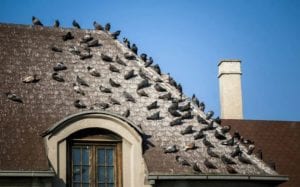
Conflict of interest rules
In July 2019, Coun. Lisa Muri brought forward a motion that asked staff to explore changing the district’s decade-old pigeon bylaw, beginning the process that ended on Monday evening.
“This is a very old archaic bylaw,” she said.
“Why do we need to allow homing pigeons to be released? I am not allowed to release my dogs. They have to be leashed … so, I would ask why would we allow pigeons?”
Forbes also recused herself from that discussion, as mandated under the conflict of interest section in B.C.’s Community Charter.
It states that a councillor with a “direct or indirect pecuniary interest in a matter” must not “attempt in any way, whether before, during or after such a meeting, to influence the voting on any question,” and that they must not “attempt to influence in any way a decision, recommendation or other action to be made or taken … by an officer or an employee of the municipality.”
FOI documents show communication
According to Freedom of Information documents provided to CBC News, after Forbes was elected — but before she was officially sworn in — she sent an email to the city’s chief planning and permitting officer, complaining about the situation and asking for action.
“The discussion and explanations for how this situation has been handled in the last 1 1/2 years were not reasonable nor acceptable,” she wrote.
And from April to June, Muri and Forbes had three email discussions where the subject line read “Pigeons,” “Repeal of the pigeon bylaw” and “Keeping of Pigeons Bylaw.”
CBC News asked Forbes questions about her letter to staff after the election, and her emails with Coun. Muri, but she did not respond. CBC News also asked Muri about the bylaw and her emails to Forbes, and she declined comment.
Mathew Bond was one of two councillors who voted against the initial motion last week. He says the bylaw isn’t an appropriate use of the district’s time.
“We’re in the middle of a regional housing crisis and I’m not sure how the pigeon bylaw got to the top of the agenda,” he said.
“Generally, if there’s one complaint, that’s what our bylaws are for and that’s why we have bylaw enforcement.”
Dulay is still hopeful he’ll be able to keep his pigeons. And wonders why things went so wrong between him and the councillor.
“She has two dogs, I never complain,” he said.
“Even though they’re always barking.”
Source
Pigeon Patrol Products & Services is the leading manufacturer and distributor or bird deterrent (control) products in Canada. Pigeon Patrol products have solved pest bird problems in industrial, commercial, and residential settings since 2000, by using safe and humane bird
deterrents with only bird and animal friendly solutions. At Pigeon Patrol, we manufacture and offer a variety of bird deterrents, ranging from Ultra-flex Bird Spikes with UV protection, Bird Netting, 4-S Bird Gel and the best Ultrasonic and audible sound devices on the market today.
Voted Best Canadian wholesaler for Bird Deterrent products ten years in a row.
Contact us at 1 877-4-NO-BIRD,(604) 585-9279 or visit our website at www.pigeonpatrol.ca
Pigeon/Pigeon Patrol / Pigeons Roosing / Vancouver Pigeon Control / Bird Spikes / Bird Control / Bird Deterrent / PIgeon Deterrent / Surrey Pigeon Control / Pest / Seagull deterrent / Vancouver Pigeon Blog / Birds Inside Home / Pigeons in the cities / Ice Pigeons / What to do about pigeons / sparrows, Damage by Sparrows, How to Keep Raccoons Away, Why Are Raccoons Considered Pests / De-fence / Pigeon Nesting / Bird Droppings / Pigeon Dropping / woodpecker control / Professional Bird Control Company / Keep The Birds Away / Birds/rats/seagull/pigeon/woodpecker/dove/sparrow/pidgeon control/pidgeon problem/pidgeon control/flying rats/pigeon problems/ bird netting/bird gel/bird spray/bird nails/bird guard

by Pigeon Patrol | May 9, 2023 | history of pigeons, MBCA, pet bird, Pigeon Control, Pigeon Droppings, Pigeon Patrol's Services, Pigeon Predators, Pigeon Spikes
For a month the researchers had traversed slender mountain ridges, crossed and re-crossed rivers that roared through canyons cloaked in tropical forest, and endured bloodthirsty mosquitoes and leeches, all in search of something that probably didn’t exist. They had just hours left for searching before they had to leave Fergusson Island, off the east coast of Papua New Guinea. Expedition co-leader Jordan Boersma reckoned their chance of success was less than 1 percent.
Winded from a climb, he plopped down on a lush hillside to catch his breath and began looking through images on the camera traps he’d just collected, not expecting to find anything. “Suddenly I was confronted with this image of what at that time felt like a mythical creature,” says Boersma, a postdoctoral researcher at the Cornell Lab of Ornithology. “It was, without exaggeration, the most surreal moment of my life.”
The camera’s display was tiny, but there was no mistaking the creature it showed: the Black-naped Pheasant-Pigeon, a species that hasn’t been documented by scientists since it was first described in 1882.
“To find something that’s been gone for that long, that you’re thinking is almost extinct, and then to figure out that it’s not extinct, it feels like finding a unicorn or a Bigfoot,” says John C. Mittermeier, director of the lost birds program at American Bird Conservancy and a co-leader of the eight-member expedition. “It’s extraordinarily unusual.”
The stunning late-September rediscovery could not have happened without guidance from local hunters with intimate knowledge of the island’s forests, the researchers say, demonstrating the invaluable role of Indigenous communities in ongoing efforts to relocate species lost to Western science. With its existence confirmed, the Black-naped Pheasant-Pigeon is almost certainly the most endangered bird in New Guinea, which underscores the urgent need to protect its habitat on Fergusson, a rugged, 555-square-mile island that, while largely undeveloped, faces pressure from logging companies.
“This is a huge discovery,” says Bulisa Iova, an expedition member and acting chief curator of the National Museum and Art Gallery in Papua New Guinea. “I have studied birds for many years, and to be part of this team to discover this lost species is a highlight for me.”
The expedition was part of The Search for Lost Birds, a collaboration between BirdLife International, Re:wild, and American Bird Conservancy, which funded the trip. The initiative aims to rediscover more than 150 avian species that haven’t been declared extinct but also have not been seen for at least a decade.
A chicken-size, ground-dwelling pigeon, the Black-naped Pheasant-Pigeon was among around 20 “lost” birds that have not been documented for more than a century. It’s one of four pheasant-pigeon species found around New Guinea, and lives only on Fergusson Island. (Some authorities consider the four varieties to be subspecies.)
Boersma previously searched for the Black-naped Pheasant-Pigeon in 2019 with Jason Gregg, a conservation biologist and Audubon magazine contributor, and local biologist Doka Nason. While the trio did not find the bird on that trip, they did turn up five bird species not previously known to live on Fergusson, which suggested there were significant gaps in what ornithologists knew about the island’s birdlife. And when they spoke with hunters, they heard reports of a bird whose description could only belong to the pheasant-pigeon.
The researchers returned to Fergusson with a larger team in early September, determined to establish trust and work closely with the island’s Indigenous inhabitants to find the species. Day after day they hiked the steep terrain, stopping to interview locals and sleeping in villages or camping in the forest. Hunters in the first few communities were unfamiliar with the large bird the researchers described. But when the team reached the remote western slope of Mt. Kilkerran, they began to meet villagers who recognized the species and referred to it by the name Auwo.
Finally, in the village of Duda Ununa, a hunter named Augustin Gregory told the researchers where he had seen the bird. He described a call that matched those of New Guinea’s other pheasant-pigeon species, which don’t live on Fergusson. And he showed the team an area, on a ridge 3,200 feet above sea level and covered in thick vegetation, where their motion-triggered camera traps were likely to snap the elusive bird. Nason, who grew up in Papua New Guinea near Fergusson, and who Boersma describes as “the most impressive field biologist I’ve worked with anywhere,” selected a spot and set up the camera.

With its vantage limited by dense understory, the site wasn’t a typical one for a camera trap, the scientists say, but the images proved it was the right one. “Unmistakable,” Gregg, an expedition co-leader, says of first seeing the photos. “Tons of mixed emotions. Everything from solemn relief of burden to fist-pumping and screaming.”
Only days later, with time to scroll through everything the traps had captured, did the team realize that another camera had recorded video of a pheasant-pigeon. Given that the images were taken several kilometers apart, they almost certainly show two individuals.
Now that scientists know the Black-naped Pheasant-Pigeon still exists, the focus becomes keeping the critically endangered species from going extinct. As with other once-lost birds, its population is likely very small and seriously imperiled. Logging by international corporations appears to be a growing threat, and introduced predators such as feral cats could take a toll on the pheasant-pigeon as they have on other endemic island birds, according to Gregg. Sustaining the long-lost species will require learning more about its behavior and population status and launching conservation projects to protect its habitat, all with Fergusson Island residents in a leading role.
“Knowing what we know about bird extinction and conservation on islands around the world, we can expect that the combination of logging and introduced species, especially introduced mammals, is going to have an impact,” Gregg says. “This land and the fate of any conservation work that happens on this land is completely up to the communities that live there and own the land.”
Beyond Fergusson Island’s luxuriant forests, the rediscovery of the Black-naped Pheasant-Pigeon raises hopes that future expeditions will turn up other species lost to science but known all along to local experts. “The way this was always going to work is that we just really lean into local knowledge and put our faith in our local partners,” Boersma says. “That’s what delivered this incredible moment for us.”
Source
Pigeon Patrol Products & Services is the leading manufacturer and distributor or bird deterrent (control) products in Canada. Pigeon Patrol products have solved pest bird problems in industrial, commercial, and residential settings since 2000, by using safe and humane bird
deterrents with only bird and animal friendly solutions. At Pigeon Patrol, we manufacture and offer a variety of bird deterrents, ranging from Ultra-flex Bird Spikes with UV protection, Bird Netting, 4-S Bird Gel and the best Ultrasonic and audible sound devices on the market today.
Voted Best Canadian wholesaler for Bird Deterrent products ten years in a row.
Contact us at 1 877-4-NO-BIRD,(604) 585-9279 or visit our website at www.pigeonpatrol.ca
Pigeon/Pigeon Patrol / Pigeons Roosing / Vancouver Pigeon Control / Bird Spikes / Bird Control / Bird Deterrent / PIgeon Deterrent / Surrey Pigeon Control / Pest / Seagull deterrent / Vancouver Pigeon Blog / Birds Inside Home / Pigeons in the cities / Ice Pigeons / What to do about pigeons / sparrows, Damage by Sparrows, How to Keep Raccoons Away, Why Are Raccoons Considered Pests / De-fence / Pigeon Nesting / Bird Droppings / Pigeon Dropping / woodpecker control / Professional Bird Control Company / Keep The Birds Away / Birds/rats/seagull/pigeon/woodpecker/dove/sparrow/pidgeon control/pidgeon problem/pidgeon control/flying rats/pigeon problems/ bird netting/bird gel/bird spray/bird nails/bird guard








